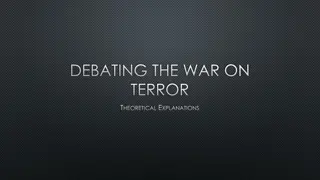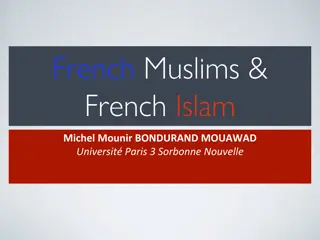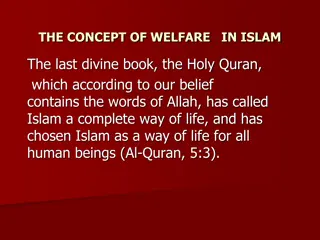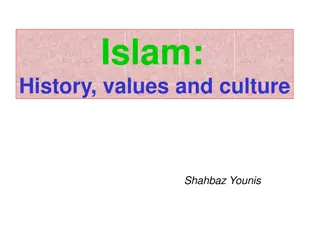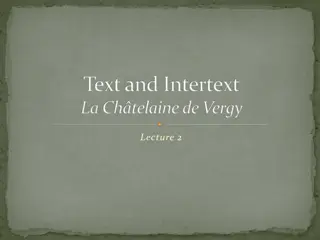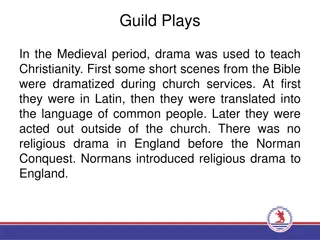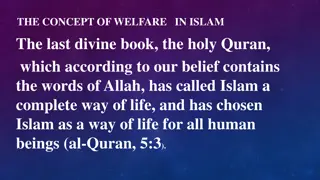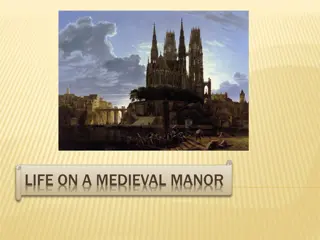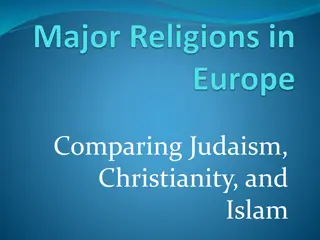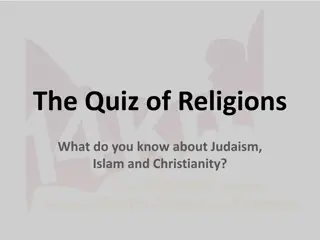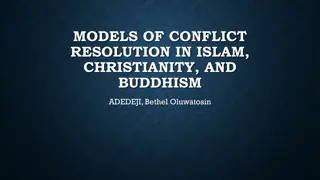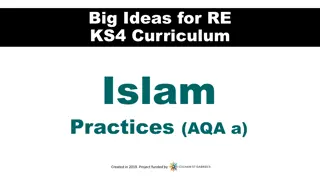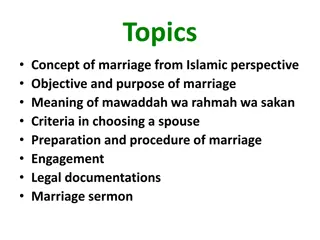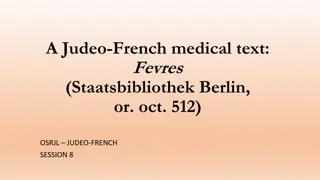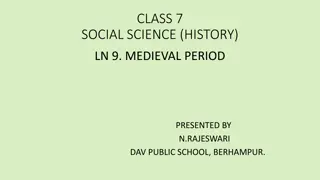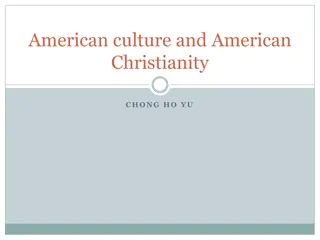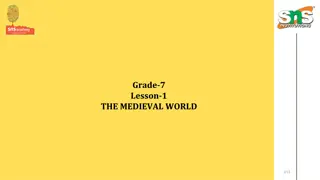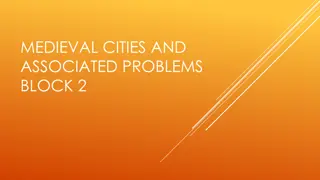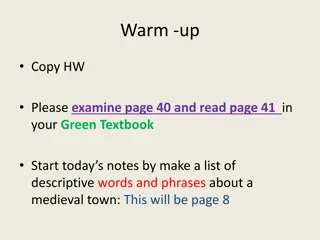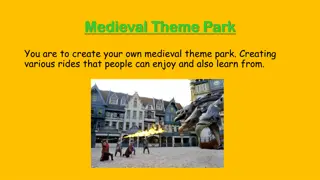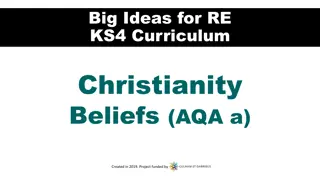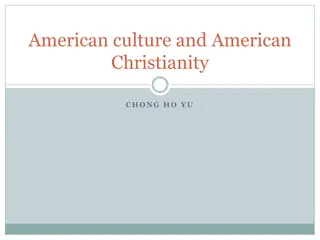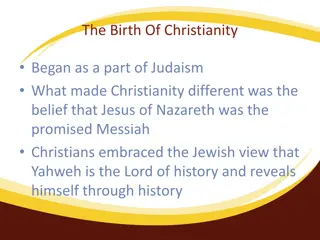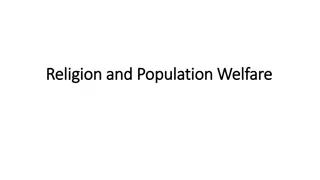European Medieval Society and the Clash of Christianity and Islam
Explore the historical context of European medieval society, focusing on feudalism, the Crusades, and the clash between Christianity and Islam. Discover how these events shaped the emergence of European civilization and led to significant cultural and religious transformations during the medieval period.
Uploaded on Sep 17, 2024 | 0 Views
Download Presentation

Please find below an Image/Link to download the presentation.
The content on the website is provided AS IS for your information and personal use only. It may not be sold, licensed, or shared on other websites without obtaining consent from the author. Download presentation by click this link. If you encounter any issues during the download, it is possible that the publisher has removed the file from their server.
E N D
Presentation Transcript
Year 8 History Overview Starter Sheets Readings
1. Write down the heading. ________________________________________________ __________________________________________________________________ _____________________________________________________________________ __________________________________________________________________ __________________________________________________________________ __________________________________________________________________ __________________________________________________________________ iii. __________________________________________________________________ __________________________________________________________________ iv. __________________________________________________________________ __________________________________________________________________ __________________________________________________________________ _____________________________________________________________________ _____________________________________________________________________ Christianity and Islam clashed in a series of wars known as the Crusades. The Christian goal into an eastern and a western empire. Both empires were weakened by a series of invasions. In the meantime, western European navigators discovered new trade routes to seventh century dominated North Africa and the Middle East. In the late eleventh century __________________________________________________________________ western Europe was embracing the learning of ancient Greece and Rome. This expansion of provided the cultural foundation for the emergence of European medieval society. One of In Europe it heralded the Scientific Revolution and the Enlightenment which The later Roman empire was transformed by becoming Christian and dividing Roman empire. This victory consolidated their empire which then commanded the eastern century the Islamic Ottomans finally captured Constantinople, the capital of the eastern of occupying Muslim Jerusalem and the Holy Land ultimately failed. In the mid-fifteenth These voyages opened up a new understanding of the world at a time when After the collapse of the Roman empire in the west, the Christian church Islam, meanwhile, had spread from the Arabian Peninsula and by the mid- Asia by sailing around Africa or heading west, across the Atlantic, to encounter the 3. Circle the metalanguage words Christian, Crusades, feudalism, Islam, medieval, 11. What do you think are the six important things we will learn about this term? 4. Write down the words you don t know the meaning of or find difficult to spell. knowledge, experience and confidence is now known as the Renaissance. Year 8 Hist - Overview Lesson 1- Introduction Reading Activity 9. What was the important feature of European medieval society? the important features of this society was feudalism. 10. Why did Islam and Christianity clash? navigators, Renaissance, Roman empire Historical context of the overview 2. Number the paragraphs. created the modern world. 7. Highlight 5 adjectives 8. Highlight 3 adverbs. 6. Highlight 5 verbs. 5. Highlight 5 nouns. Mediterranean. Americas. ii. v. i.
Each side had a ruler in charge of it. But the ruler who was in charge of Rome was the senior emperors' - and twenty of these men were killed by rivals! Clearly law and order and respect a. ___________________________________________________________________ b. ___________________________________________________________________ c. ___________________________________________________________________ their own gods. They lived just outside the boundaries of the Roman Empire and traded with 12.Which emperor changed the capital of Rome ? ________________________________ 1. Write down the heading. ________________________________________________ 13.Was this wise? _______________________________________________________ 11. Which emperor divided the Roman Empire? __________________________________ The Roman Army was spread throughout Western Europe. Each army fought to 10.Which tribes threatened Rome? __________________________________________ have its leader as Emperor. Between AD 211 and AD 284, there were twenty-three 'soldier- 3. Circle the metalanguage words : Byzantium., Constantine, Diocletian , Angles, Saxons and the Romans. They were always looking for a chance to move into the richer areas controlled than Rome and firmly in the eastern empire. This left the western empire very vulnerable Constantine was Rome's first Christian emperor and he is considered to have been a strong ruler. He believed that Rome as a city was too far away from vital areas of the empire and Rome also experienced a succession of poor emperors who simply were not capable of doing motives were, Constantine s decision was a poor one.. Constantinople was much further east In AD 284, After some thought, Emperor Diocletian decided the only thing to Denmark, Germany and the Netherlands. These tribes were not Christians but worshipped do with Rome was to split the empire in half. That way, it would be easier to manage. This ___________________________________________________________________ created two Roman empires - the Western Roman Empire and the Eastern Roman Empire. In AD 307, Constantine became emperor. He ruled from AD 307 to AD 337. Tribes of Angles, Saxons and Jutes lived in Northern Europe, in what is now therefore, moved the capital of the empire to a new city Constantinople. Whatever the This could only bring them into conflict with the Romans. At about AD 190, Year 8 Hist - Overview Lesson 2 - The fall of Ancient Rome Reading Activity The Eastern Roman Empire (Turkey/parts of Asia) included the city of Byzantium. 4. Write down the words you don t know the meaning of or find difficult to spell. The Western Roman Empire (Europe/North Africa) included the city of Rome. 9. Write down 3 things you have learnt from reading this passage. The fall of Ancient Rome started from about AD 190. though the eastern empire was hardly free from attacks. by the Romans. Only the Roman army kept them out. for that within Rome itself was at fault. Jutes, Romans, Western Europe 2. Number the paragraphs. 7. Highlight 5 adjectives 8. Highlight 3 adverbs 6. Highlight 5 verbs. 5. Highlight 5 nouns. the job. ruler.
king in the year 1016 AD. King Canute was king of England, Norway and Denmark and was very After about 400 years, another group of people started to attack England. This raid the coasts of England. The British asked Rome for help in 410 AD. The reply came back: When King Canute died, his sons Harold Harefoot and Harthacanute became king. Then when The decline of Rome gave the Angles, Saxons and Jutes their chance at Britain. 11. Why was Britain a good place to live? _______________________________________ a. ___________________________________________________________________ b. ___________________________________________________________________ c. ___________________________________________________________________ 1. Write down the heading. ________________________________________________ British. It was at this point that the Anglo-Saxons began to take over and settle in England. _____________________________________________________________________ _____________________________________________________________________ 10.Which tribes threatened Rome? __________________________________________ stealing valuables and people, then going home. Soon though, the Vikings began to stop going shiploads of soldiers. Once in England. the soldiers and their Anglo-Saxon chiefs refused to was the Vikings from Denmark and Norway. The Vikings also attacked Anglo-Saxons houses, Pushed by the Goths, Vandals and Huns the Angles, Saxons and Jutes began to words would become the English and England we use today. Some of the Roman people went To them Britain seemed a rich and easy prize. There were precious objects and gold in the villas and towns. The fields were fertile. There were no high mountains to cross. The many The Vikings lived in the north of England and called this part of England: the Danelaw. The This was what the British tried to do. Short of soldiers, they decided to hire powerful. He was a Viking but wanted to be friends with the Angles and the Saxons, so he England would not be together as one country again until King Canute became ___________________________________________________________________ Huns, Anglo-Saxons, Hengist and Horsa, Vikings from Denmark, King Canute, England, 3. Circle the metalanguage words British, Angles, Saxons and Jutes, Goths, Vandals and They spoke Anglish and called the country they now lived in Angland. These Sometime in the 440 s, they demanded more money, and then attacked the In 428 AD the Anglo-Saxon chiefs. Hengist and Horsa. arrived with three Norway and Denmark, Harold Harefoot and Harthacanute, Edward the Confessor Year 8 Hist - Overview Lesson 3 - The fall of Ancient Rome Reading Activity 4. Write down the words you don t know the meaning of or find difficult to spell. back to Rome, but some of them stayed and learned the new way of doing things. 9. Write down 3 things you have learnt from reading this passage. Angles and the Saxons had to live in the south of England. some tribes of Anglo-Saxons to fight off the others. made a set of laws telling people how to get along. they died Edward the Confessor became king. Britain and the end of the Roman Empire home and started living in England. rivers gave easy routes inland. This process took a long time. 'Look to your own defences'. 2. Number the paragraphs. 7. Highlight 5 adjectives 8. Highlight 3 adverbs 6. Highlight 5 verbs. 5. Highlight 5 nouns. go home..
will also be learning about Mohammad who founded Islam the religion of the Muslims. He too people s lives. Nowadays in Australia a lot of our institutions are founded on Christianity and background knowledge of Jesus Christ and the stories of the New and Old testaments. You a. ___________________________________________________________________ b. ___________________________________________________________________ c. ___________________________________________________________________ 1. Write down the heading. ________________________________________________ when he served and cared for people. It is said that Jesus was a healer & the miracle Jesus was a man born in Judea part of the Roman Empire. It was be the Holy Grail. But the chief Jews were plotting against him and he was arrested at leader. He had to drag his cross through the streets. 3 days later his tomb was empty cheering their Messiah. The Messiah was prophesised in Jewish history to be the one husband Joseph had travelled to Bethlehem in Judea where she gave birth in a stable. said this bread is my body and this wine is my blood. The cup he used is supposed to influence on human history. In the Medieval period Christianity and the church controlled Aged 30 he moved away & chose 12 men as disciples. He spent 3 in our literature there is a lot of Christian symbolism. It is important that you have some ___________At aged 33 Jesus was crucified the Jews had convinced the Romans people of diseases like leprosy, raising a person from the dead, walking on water and However he was a real person and what he did in his life is recorded. He has had a huge ___________________________________________________________________ God would send to save the people. He had a last supper with his disciples where he years teaching people about God. This period of time is called his ministry a time said that his mother was a virgin called Mary who God made pregnant. Mary and her stories were written to show that he was special. These stories included him curing that he was a threat to peace and stability. Jesus was crucified on cross as a rebel dawn & put on trial. Judas, one of the disciples betrayed him for 30 pieces of gold has had a huge influence on the world. It is interesting to note that both were men of There are people who believe or don t believe that Jesus Christ was the son of God. __________Jesus entered Jerusalem on a donkey & people waved palm leaves, 3. Circle the metalanguage words: influence, institutions, Medieval, origins, stories, with there were rumours of Resurrection (rising from the dead) and sightings. 4. Write down the words you don t know the meaning of or find difficult to spell. humble origins who preached a religion of love, charity and tolerance. Year 8 Hist - Overview Lesson 4 Jesus Christ Reading Activity 9. Write down 3 things you have learnt from reading this passage turning five fishes into a feast that fed hundreds of people. Jesus was raised a devout Jew. He became a carpenter. Number the following into chronological order. 2. Number the paragraphs. 7. Highlight 5 adjectives 8. Highlight 3 adverbs. 6. Highlight 5 verbs. 5. Highlight 5 nouns. _________ _________ symbolism
next several centuries, Islam reached as far as India in the east, and to Spain in the west. The spread the Central Asian Arabian desert and soon spread to east Asia, Central Europe and North Africa. The spirits, medieval Muslims were developing hospitals and surgical instruments. The Islamic Empire was mathematics, algebra, astronomy, medicine, physics and other disciplines were developed and are still a. ___________________________________________________________________ b. ___________________________________________________________________ c. ___________________________________________________________________ 12.___________________________________________________________________ ___________________________________________________________________ ___________________________________________________________________ Roman Empires were defeated by the much less equipped and out-numbered Muslim armies. Over the 1. Write down the heading. ________________________________________________ Islam spread rapidly from the Arabian peninsula in less than 30 years. The Persian and _____________________________________________________________________ _____________________________________________________________________ _____________________________________________________________________ 10.What is the core teaching of Islam? _______________________________________ in use today based on the principles of the early Muslim scholars. Islam originated around 600 AD in religion started with the teachings of Prophet Muhammad who is considered to be the messenger of one of the largest and most influential empires in history. They ruled from Asia to Spain and North the Medieval Period. Islam was founded by the Prophet Mohammad In 622cE, and people who follow __________________________________________________________________ continued through traders to southeast Asia, where for example, Indonesia, today's largest Muslim The arrival of Islam brought the most profound religious changes to the world during Medieval Period. Sufis aimed to draw closer to God through good deeds and a life of self-discipline. belong to the Sunni denomination. Sufism was a movement within Islam that was popular during the At a time when most Europeans believed that illness was caused by bad smells or evil ___________________________________________________________________ During the peak of Islam's rule, when Europe was in the Dark Ages, the sciences of Islam split into two factions, Sunni and Shiite, in the early 660s CE. Most Muslims 3. Circle the metalanguage words: Allah., Dark Ages, disciplines, medieval, Muhammad, teachings and revelations were written down in the Muslim holy book, the Qu ran Islam's core 4. Write down the words you don t know the meaning of or find difficult to spell. 9. Write down 3 things you have learnt from reading this passage Year 8 Hist - Overview Lesson 5 Islam Reading Activity 11. What are the legacies of the Medieval Islamic Empire? country, received the message of Islam through Arab traders. the faith of Islam are called Muslims. Mohammad's the one and only, formless, all-powerful God, Allah. Africa as well as Cyprus and the Near East. 13. How did Indonesia become Muslim? teaching is submission to the will of God. profound, Qu ran, Sunni and Shiite 2. Number the paragraphs. 7. Highlight 5 adjectives 8. Highlight 3 adverbs. 6. Highlight 5 verbs. 5. Highlight 5 nouns. Islam
The C_________ were a series of _______ where Christians and Muslims fought to control the Holy where the founder of the faith, the Prophet Muhammad stayed. Muslims believe in the teaching Judaism In AD 70, the Romans destroyed the most important temple of the Jewish faith that ____________________________________________________________________________ _________ happened there. It is holy to the Muslim religion, _________, too. Muslims believe their that the son of god is yet to appear and they are God s chosen people. It all comes down to a question had been built by King David. But Jerusalem is still one of the holiest cities for Jewish people. Christianity The hill of Calvary in Jerusalem was the place where Jesus Christ died. From the c. ___________________________________________________________________ a. ___________________________________________________________________ b. ___________________________________________________________________ Jews and Jesus were all true prophets of God but Mohamad is his final messenger. The Jews believe 1. Write down the heading. ________________________________________________ believe that Jesus is the son of God like the Christians do. Muslims believe that the prophets of the All 3 religions believe that they are the truth. However all 3 believe in the same powerful God. They Lots of people from across Europe went on the Crusades. The most famous English person was King Richard I(the Lionheart ). An important Welsh man was Gerald of Wales, he convinced fourth century, Christian pilgrims from all over the world came to visit Jerusalem. Christians Different types of people went, knights, poor people, churchmen, rich people, women, even prophet, Mohammed, visited Heaven from there. Jerusalem and the surrounding area (what we call Islam Jerusalem is the home of a very important mosque (a Muslim place of worship). It is ___________________________________________________________________ all acknowledge they believe in the same god. The difference is that Judaism and Muslims don t modern day Israel) was known as the ______ Land. The crusades dragged on and off for about Land. J__________ is a holy place for Christians because many important events in the life of several ______ years. English knights and soldiers mainly fought in what is known as the Third ______________________________________________________________________ Jersalem was important to 3 groups of people and they fought to gain access and control of 3. Write down the words you don t know the meaning of or find difficult to spell. children (in fact a group of children went on a Crusade all by themselves in 1212). ________________________________________________________________ Crusades, Holy, hundreds, Islam, Jerusalem, Jesus, Richard the Lionheart, wars Year 8 Hist - Overview Lesson 6 The Crusades Reading Activity 9. Write down 3 things you have learnt from reading this passage believe that Jesus Christ is the son of God. They read the Bible. 7. Why do you think they might have gone on a holy crusade? ____________________________________________. Jewish people believe in one God and read the Tenakh. Crusade between the years 1189 and 1192 under the king, of the Prophet Muhammad and read the Koran. Why is Jerusalem important to 3 religions? Jerusalem. This battle continues today! people to go on crusade. 2. Number the paragraphs. Who went on the Crusades? 7. Highlight 5 adjectives What was the Crusades? 8. Highlight 3 adverbs 6. Highlight 5 verbs. 5. Highlight 5 nouns.
Chang'an (now Xian), Baghdad, Cairo and Constantinople (now Istanbul). The Silk Road had/has century the expansion of the Mongol Empire across Asia, the Middle East and Eastern Europe ______________________________________________________________________ ______________________________________________________________________ ______________________________________________________________________ ______________________________________________________________________ ______________________________________________________________________ ______________________________________________________________________ ______________________________________________________________________ a. ___________________________________________________________________ b. ___________________________________________________________________ c. ___________________________________________________________________ colonies, including timber and precious minerals. For many of the peoples of Africa, Asia and 1. Write down the heading. ________________________________________________ Numerous trade routes were/was spread across Afro-Eurasia. The network of Road has/had operated between Asia and Europe since ancient times. Despite the name, silk the Americas, the arriving/arrival and settlement of Europeans resulted in loss of land, loss The European trading ports /bought/brought a great deal of wealth to Europe, and the Americas. In some of their colonies, they creates/created huge plantations of tea, addition to the trading ports, Europeans soon established colonies throughout Africa, Asia ___________________________________________________________________ ___________________________________________________________________ routes known as the Silk Road is/are perhaps the most famous of these/those. The Silk while sea travel led/lead to the discovery of uncharted lands, including the Americas. In was/were not the only product to be traded-spices, tea, salt, ivory, ceramics, slaves and that/which disrupted trade between Asia and the Mediterranean. However, in the 13th precious gems was/were brought across the vast distances to and from the markets of of self-government, economic ruin and slavery Indigenous peoples, such as those of the coffee, sugar and tobacco. They also harvest/harvested the natural resources of their Americas, faced the additional blight of European diseases, against which they had no been in decline since the early 800s CE, due to the growth of the Islamic Empires, 4. Write down the words you don t know the meaning of or find difficult to spell. Year 8 Hist - Overview Lesson 7 The Age of Exploration Reading Activity 9. Write down 3 things you have learnt from reading this passage. 11. What were the disadvantages of the Age of Exploration? 10. What were the advantages of the Age of Exploration? 3. Circle the metalanguage words : Silk Road, trade allows/allowed trade to thrive across Afro- Eurasia. 2. Number the paragraphs. Trade in Medieval Europe 7. Highlight 5 adjectives 8. Highlight 3 adverbs 6. Highlight 5 verbs. 5. Highlight 5 nouns. Correct the tenses. immunity
The Enlightenment was an important philosophical movement in the Early Modern Period. According to looked as if they were three dimensional; architects started to experiment with the forms of Ancient moveable metal letters. He used this to print Latin textbooks and leaflets about political and religious observation and experimentation to prove scientific theories. Within a few hundred years, scientists' Towards the end of the fifteenth century, scientific method began to break away from making decisions. The Enlightenment also introduced new ideas about freedom and human rights some (c.1450-A50cs). The Early Modern Period is known for the emergence of new ideas about art, science a. ___________________________________________________________________ b. ___________________________________________________________________ c. ___________________________________________________________________ printed Bible would be within the means of almost everyone. Gutenberg's printing press was probably 1. Write down the heading. ________________________________________________ Enlightenment thought, reason and science (rather than tradition or religion) should be the basis for the most significant invention of the Medieval Age. It ushered in a new age-the Early Modern Period the Sun rather than the other way around, that matter was composed of tiny atoms and that gravity At first, only wealthy people could afford to buy the Gutenberg Bible, but eventually a _____________________________________________________________________ _____________________________________________________________________ of which had been slowly developing since the late Medieval Period. These freedoms and rights were New scientific discoveries included the understanding that the Earth revolved around The Renaissance was a cultural movement in Europe lasting from the 15th to the 17th discoveries, exploration by sea and the growth of universities in the Medieval Period inspired a new seen as inalienable, or absolute, and were to be available to all people, regardless of the social class was a constant. While some historians describe the changes in scientific method as a 'revolution, it Greece and Rome in their building designs; and philosophers developed the idea of humanism, which approach to art and architecture. It was not so much a break with the Medieval Period as it was a able to sell the Bibles for 30 florins-rather expensive for the times, but still much cheaper than a ideas. In 1455 ce, Gutenberg produced his most famous book-the Gutenberg Bible. Gutenberg was into which a person had been born. In theory at least, the life of a peasant was worth the same as flowering of medieval culture. Artists began to develop perspective in painting so that flat images In1436 CE, German Johannes Gutenberg invented a mechanised printing press with and philosophy. All of these new ideas became widespread across Europe, thanks to the printing inalienable, individuals, observation, philosophical , political, revolved , significant the older scientific traditions established by Ancient Greek and Arab scholars, in favour of centuries. The expansion of trade with Arabic, Asian and African merchants, new scientific 3. Circle the metalanguage words : cultural, expensive, flowering, humanism, ideas, That all sound really good. Humans were being pretty terrific were they not? 4. Write down the words you don t know the meaning of or find difficult to spell. encouraged people to believe that they were individuals with the potential to be creative. was actually a more gradual advance that was built on centuries of medieval science. knowledge of astronomy, biology chemistry and physics had changed dramatically. hand copied Bible, which was the only other type of Bible available in those days. 9. Write down 3 things you have learnt from reading this passage. Year 8 Hist - Overview Lesson 8 - Achievements 2. Number the paragraphs. 7. Highlight 5 adjectives The Scientific Revolution 8. Highlight 3 adverbs 6. Highlight 5 verbs. 5. Highlight 5 nouns. The Enlightenment The Printing Press The Renaissance that of a king. press.


